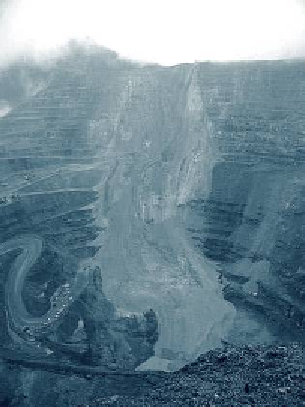Environmental Engineering Reference
In-Depth Information
During the mining period,
maintenance of slope stability
and minimization of related
operational health and safety
risks are of prime concern.
the mining period, maintenance of slope stability and minimization of related opera-
tional health and safety risks are of prime concern (
Case 13.3
). Excavated slopes may
create other environmental concerns including increased erosion, rapid runoff, risks to
wildlife, and the exposure of potentially reactive natural materials.
Dumping or placement of overburden soils, tailings, waste rock, or other materials cre-
ates new i ll slopes. The geotechnical stability of i ll slopes is of concern because, compared
to most
in situ
materials, they are less dense, relatively weak, and more likely to absorb
water. Water saturation of waste material can trigger slope failure. Fill materials may in
some cases also be subject to rapid disintegration, or to decomposition, yielding acids and
releasing potentially toxic metals. Slope failure can result in direct release or direct expo-
sure of these materials to the surrounding environment.
Mining and associated activities may also trigger landslides through natural soil and
rock masses. This commonly occurs in pit walls, (Case 13.3) but may also occur along access
and haulage roads, particularly where these involve excavations into steep hillsides. Many
natural slopes in mountainous terrain are only marginally stable and require only a rela-
tively minor change to become unstable. Merely clearing vegetation or excavating a pipe-
line trench may, in some instances, be sufi cient to destabilize an entire mountain slope.
Many natural slopes in
mountainous terrain are only
marginally stable and require
only a relatively minor change to
become unstable.
Subsidence and Earthquakes
Mine subsidence is the movement of the surface resulting from the collapse of overlying
strata into mine voids, a subject matter well-documented by Bell and Donnelly (2005).
The potential for subsidence exists for all forms of underground mining. Subsidence may
manifest itself in the form of sinkholes or troughs. Sinkholes are usually associated with
the collapse of a portion of a mine void (such as a room in 'room and pillar' mining); the
extent of the surface disturbance is usually limited in size. Troughs are formed from the
subsidence of large portions of the underground void and typically occur over areas where
most of the resource has been removed
(
Figure 13.3
)
. Typically, such subsidence is not evi-
dent at the surface except along its margins.
The effects of subsidence include the development of sinkholes or depressions in the land
surface that may interrupt surface water drainage patterns; ponds and streams may be
drained or channels redirected. Farmland can be affected to the point that cultivation is
The potential for subsidence
exists for all forms of
underground mining.
CASE 13.3
The Collapse of the Southern Part of the Grasberg Pit Wall
In October 2003 a landslide arrived in a torrent of
2.5 million tonnes of rock and mud at the Freeport-
McMoran gold and copper mine in Papua, Indonesia. Heavy
rain had fallen for fi ve days, and water was trapped in
the slope building up water pressure in the steep southern
part of the pit wall. Because this section was always most
at risk, the company had rigged it with more than a dozen
extensometers - devices that measure the rate of move-
ment at 20 minutes intervals. Two days before the pit wall
failure, engineers noticed an accelerated rock movement
and the company moved its stationary mining equipment
out of the zone where it expected the slide to hit. However
the engineers underestimated the magnitude of the
landslide; they did not expect the slide to be so liquid.
Eight workers lost their lives in this unfortunate accident.
Source: Based on The Syndey Morning Herald, November
1, 2003









Search WWH ::

Custom Search